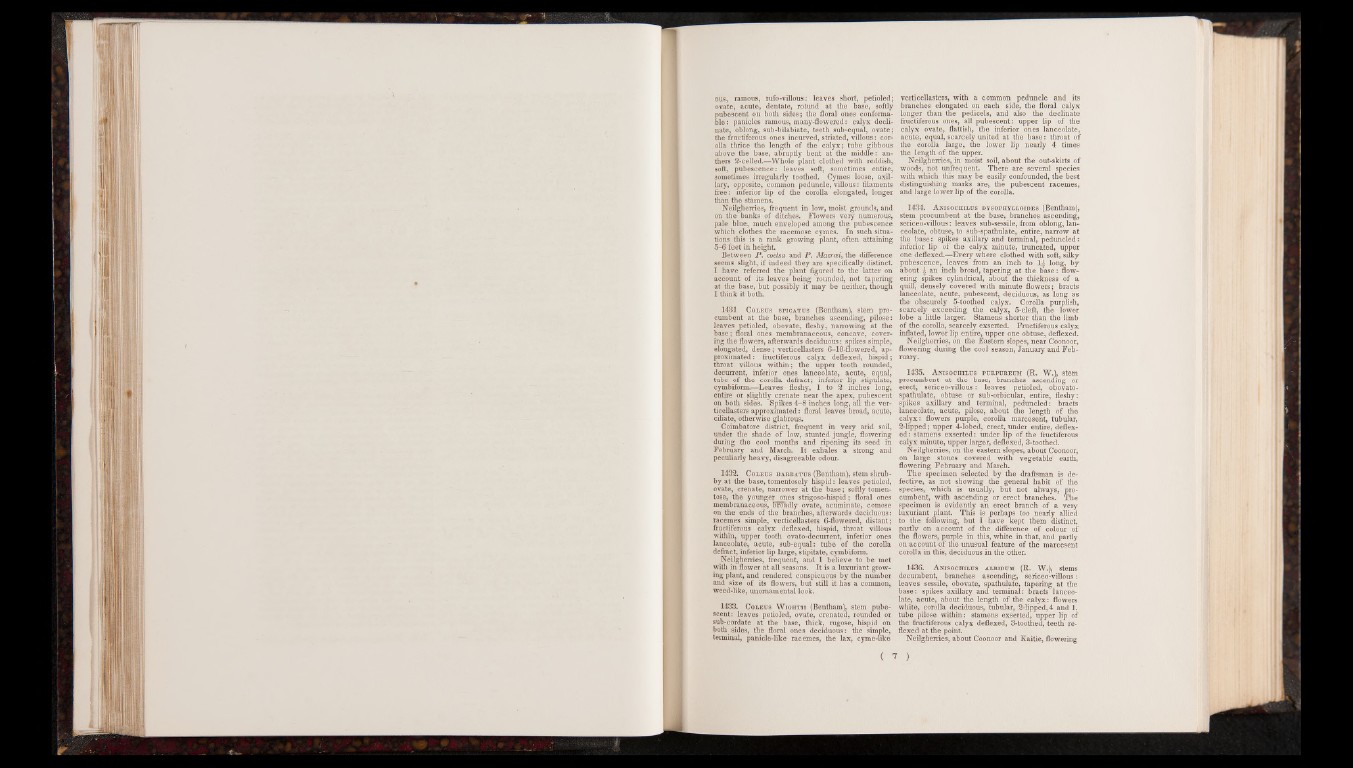
&M.
ous, ramous, rufo-villous: leaves short, petioled;
ovate, acute, dentate, rotund at the base, softly
pubescent on both sides; the floral ones conformable:
panicles ramous, many-flowered: calyx decli-
nate, oblong, sub-bilabiate, teeth sub-equal, ovate;
the fructiferous ones incurved, striated, villous: corolla
thrice the length of the calyx; tube gibbous
above the base, abruptly bent at the middle: anthers
2-celIed.—Whole plant clothed with reddish,
soft, pubescence: leaves soft, sometimes entire,
sometimes irregularly toothed. Cymes loose, axillary,
opposite, common peduncle, villous: filaments
free: inferior lip of the corolla elongated, longer
than the stamens.
Neilgherries, frequent in low, moist grounds, and
on the banks of ditches. Flowers very numerous,
pale blue, much enveloped among the pubescence
which clothes the racemose cymes. In such situations
this is a rank growing plant, often attaining
5 -6 feet in height.
Between P . coetsa and P . Macrai, the difference
seems slight, if indeed they are specifically distinct.
I have referred the plant figured to the latter on
account of its leaves being rounded, not tapering
at the base, but possibly it may be neither, though
I think it both.
1431 Coleus spicatus (Bentham), stem procumbent
at the base, branches ascending, pilose:
leaves petioled, obovate, fleshy, narrowing at the
base; floral ones membranaceous, concave, covering
the flowers, afterwards deciduous: spikes simple,
elongated, dense; verticellasters 6-10-flowered, approximated
: fructiferous calyx deflexed, hispid;
throat villous within; the upper tooth rounded,
decurrent, inferior ones lanceolate, acute, equal,
tube of the corolla detract; inferior lip stipulate,
cymbiform.—Leaves fleshy, 1 to 2 inches long,
entire or slightly crenate near the apex, pubescent
on both sides. Spikes 4 -8 inches long, all the verticellasters
approximated: floral leaves broad, acute,
ciliate, otherwise glabrous.
Coimbatore district, frequent in very arid soil,
under the shade of low, stunted jungle, flowering
during the cool months and ripening its seed in
February and March. It exhales a strong and
peculiarly heavy, disagreeable odour.
1432. Coleus barbatus (Bentham), stem shrubby
at the base, tomentosely hispid: leaves petioled,
ovate, crenate, narrower at the base; softly tomen-
tose, the younger ones strigoso-hispid; floral ones
membranaceous, broadly ovate, acuminate, comose
on the ends of the branches, afterwards deciduous:
racemes simple, verticellasters 6-flowered, distant;
fructiferous calyx deflexed, hispid, throat villous
within, upper tooth ovato-decurrent, inferior ones
lanceolate, acute, sub-equal: tube of the corolla
defract, inferior lip large, stipitate, cymbiform.
Neilgherries, frequent, and I believe to be met
with in flower at all seasons. It is a luxuriant growing
plant, and rendered conspicuous by the number
and size of its flowers, but still it has a common,
weed-like, unornamental look.
1433. Coleus W ightii (Bentham), stem pubescent:
leaves petioled, ovate, crenated, rounded or
sub-cordate at the base, thick, rugose, hispid on
both sides, the floral ones deciduous: the simple,
terminal, panicle-like racemes, the lax, cyme-like
verticellasters, with a common peduncle and its
branches elongated on each side, the floral calyx
longer than the pedicels, and also the declinate
fructiferous ones, all pubescent: upper lip of the
calyx ovate, flatfish, the inferior ones lanceolate,
acute, equal, scarcely united at the base: throat of
the corolla large, the lower lip nearly 4 times
the length of the upper.
Neilgnerries, in moist soil, about the out-skirts of
woods, not unfrequent. There are several species
with which this may be easily confounded, the best
distinguishing marks are, the pubescent racemes,
and large lower lip of the corolla.
1434. Anisochilus dysophylloides (Bentham),
stem procumbent at the base, branches ascending,
sericeo-villous: leaves sub-sessile, from oblong, lanceolate,
obtuse, to sub-spathulate, entire, narrow at
the base: spikes axillary and terminal, peduncled:
inferior lip of the calyx minute, truncated, upper
one deflexed.—Every where clothed with soft, silky
pubescence, leaves from an inch to 1^ long, by
about ^ an inch broad, tapering at the base: flowering
spikes cylindrical, about the thickness of a
quill, densely covered with minute flowers; bracts
lanceolate, acute, pubescent, deciduous, as long as
the obscurely 5-toothed calyx. Corolla purplish,
scarcely exceeding the calyx, 5-cleft, the lower
lobe a little larger. Stamens shorter than the limb
of the corolla, scarcely exserted. Fructiferous calyx
inflated, lower lip entire, upper one obtuse, deflexed.
Neilgherries, on the Eastern slopes, near Coonoor,
flowering during the cool season, January and February.
1435. Anisochilus purpureum (R. W.), stem
procumbent at the base, branches ascending or
erect, sericeo-villous: leaves petioled, obovato-
spathulate, obtuse or sub-orbicular, entire, fleshy:
spikes axillary and terminal, peduncled: bracts
lanceolate, acute, pilose, about the length of the
calyx: flowers purple, corolla marcesent, tubular,
2-lipped; upper 4-lobed, erect, under entire, deflexed:
stamens exserted: under lip of the fructiferous
calyx minute, upper larger, deflexed, 3-toothed.
Neilgherries, on the eastern slopes, about Coonoor,
on large stones covered with vegetable! earth,
flowering February and March.
The specimen selected by the draftsman is defective,
as not showing the general habit of the
species, which is usually, but not always, procumbent,
with ascending or erect branches. The
specimen is evidently an erect branch of a very
luxuriant plant. This is perhaps too nearly allied
to the following, but I have kept them distinct,
partly on account of the difference of colour of
the flowers, purple in this, white in that, and partly
on account of the unusual feature of the marcesent
corolla in this, deciduous in the other.
1436. Anisochilus albidum (R. W.), stems
decumbent, branches ascending, sericeo-villous:
leaves sessile, obovate, spathulate, tapering at the
base: spikes axillary and terminal: bracts lanceolate,
acute, about the length of the calyx: flowers
white, corolla deciduous, tubular, 2-lipped, 4 and 1,
tube pilose within: stamens exserted, upper lip of
the fructiferous calyx deflexed, 3-toothed, teeth reflexed
at the point.
Neilgherries, about Coonoor and Kaitie, flowering